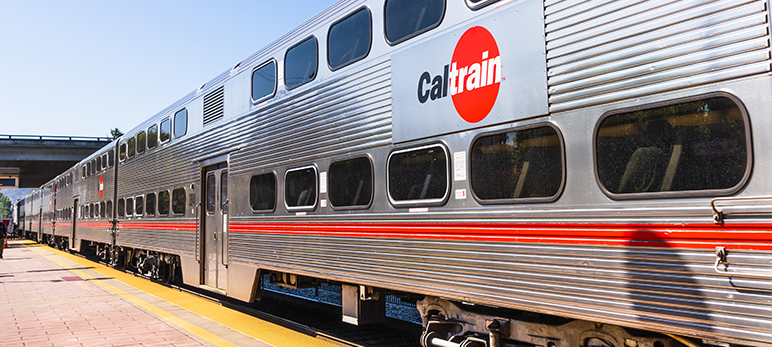Passing Measure RR will support essential healthcare workers who depend on Caltrain during Covid-19, fund equity policies that would make Caltrain accessible to many more low-income people and reduce pollution by keeping many thousands of cars off the road.
A sales tax is not an ideal way to fund public transit, but given the policy changes that prioritize access for low-income communities, and the additional benefit to local transit service by saving money for VTA, SamTrans, and MUNI, it’s clear that the net benefit for our communities outweighs the cost.
And the alternative—Caltrain shutting down entirely—is even worse.
Measure RR would fund unprecedented new equity and connectivity policies that were recently approved by the Caltrain board.
These policies and programs will improve the racial and income diversity of Caltrain’s ridership, with more affordable fares, improvements to local transit connections, increased service and access to stations serving low-income communities of color, and schedules that better serve people traveling outside 9-to-5 commute hours, such as restaurant workers who leave late and work on weekends.
Currently, SFMTA, VTA, and SamTrans are legally required to fund Caltrains operations. By providing a dedicated revenue source for Caltrain, those contributions are freed up to run local bus service, which disproportionately serves low-income communities and people of color. These agencies are struggling financially due to the public health crisis, and service cuts are on the way. The money freed up by passing Measure RR would help keep local transit service running.
Caltrain’s equity studies showed that before Covid, about 30 percent of Caltrain’s riders were lower income. Now, during the pandemic, half of all trips are serving essential workers in healthcare, life sciences and government, while another 10 percent are trips to medical appointments, according to new data shared at the last Caltrain board meeting.
The share of low- and middle-income riders has doubled, with more than twice the share of people who qualify for low-income housing assistance and more than twice the share of people in households making less than $100,000 per year, with a majority of households without access to a car. The proposed policy changes included in Measure RR will build on this trend.
Plans for housing on the Peninsula corridor from San Francisco through San Jose, including affordable housing would be at great risk if Caltrain’s future was uncertain.
Caltrain last year adopted a policy requiring at least 30 percent affordable housing on land Caltrain owns, and many cities require 15 percent or more affordable housing in any development. And living near transit allows households to own fewer cars, saving $8,000 or more per year. If Caltrain were shuttered, it would be much harder to get affordable housing approved and built near stations.
Pre-Covid, Caltrain took the equivalent of 400 million driving miles off of our highways. Improvements funded by Measure RR could reduce driving by another 240 million miles, removing 110 additional metric tons of carbon emissions and large amounts of particulate pollution each day.
Caltrain is also currently being electrified, and the new electric service will eliminate the emissions from Caltrain’s diesel engines. Without Measure RR, Caltrain won’t be able to pay to run the cleaner electric trains.
Low-income communities in our area are clustered near highways and experience the greatest impact from particulate pollution with disproportionately high rates of asthma and other respiratory diseases. Measure RR keeps cars off the road, which protects the health of communities—even for people who don’t ride Caltrain.
For all of these reasons, Youth Leadership Institute, Housing Leadership Council, TransForm, Friends of Caltrain, and other transit justice allies support Measure RR.
These groups are members of TEAMC, a San Mateo County-based environmental justice coalition whose participants represent transit, active transportation, environmental, and affordable housing groups, and organizations representing low-income and transit-dependent San Mateo County residents.
Adina Levin is the executive director of Friends of Caltrain. Opinions are the author’s own and do not necessarily reflect those of San Jose Inside. Send op-ed pitches to
co******@me*******.com
" target="_blank" rel="noopener noreferrer">
co******@me*******.com
.


The only people that use Caltrain are high tech workers. If they aren’t willing to pay for it with higher fares then shut it down. The only reason the share of low income riders went down is because the rich tech workers are staying home. The idea that significant number of lower income workers are using Caltrains isn’t accurate. Low income workers use VTA or SamTrans.
This idea that poor workers should pay sales tax to help rich tech workers is nuts.
If you can’t afford to live here then MOVE.
This whole affordable housing idea is NUTS. The only way to really get financially ahead in America is to BUY your own home. You get into affordable housing and you are likely never to get out of it. Then you make it to 65 being poor and unable to support yourself.
Just get rid of affordable housing programs and the problem solves itself.